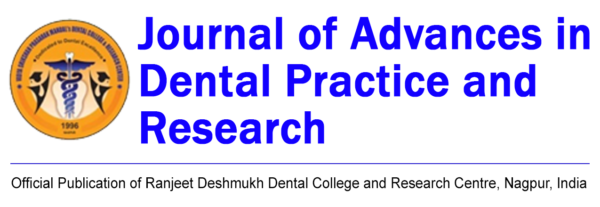Translate this page into:
Evaluation and assessment of dental fear and anxiety
*Corresponding author: Manjiri Kiran Datey, Intern, Department of Oral Pathology, Ranjeet Deshmukh Dental College and Research Centre, Nagpur, Maharashtra, India. manjiridatey4@gmail.com
-
Received: ,
Accepted: ,
How to cite this article: Datey MK, Karale S, Dive A. Evaluation and assessment of dental fear and anxiety. J Adv Dental Pract Res. 2023;2:39-43. doi: 10.25259/JADPR_22_2023
Abstract
Objectives:
The aim of this study is to evaluate and assess the knowledge of dental fear and anxiety among general population.
Material and Methods:
A prospective cross-sectional study involving 400 participants was conducted among the general population. The validated questionnaire was given out to the participants. The questionnaire has multiple-choice questions and was easy to understand and respond.
Results:
Four hundred participants from the general population have participated in the study. It was found that the majority of the general public still avoids seeking dental treatment as they are afraid to go to the dentist.
Conclusion:
Participants in the research had a knowledge of the consequences of postponing dental care. Dental treatment is delayed due to dental fear and anxiety. Participants thought that they needed good medical advice as well as proper education on alternative relaxing methods like meditation.
Keywords
Dental fear
Anxiety
Evaluation
General population
INTRODUCTION
In this study, the words “dental fear” and “dental anxiety” shall be combined under the general heading of “dental fear and anxiety” (DFA). The primary obstacle preventing individuals from receiving dental care, according to the majority of patients, is “fear of pain.” The extreme dental fear of patients leads to avoidance of treatment and deterioration of oral health, whichin turn, reinforces fear.[1,2]
DFA thought to be a major barrier that prevents people from going to the dentist regularly and can have substantial consequences for a person’s level of fear. It has been linked to negative oral health quality of life, which has been demonstrated to have an impact on overall quality of life. In addition, it has been noted that patients with blood-injury-injection phobia have greater anxiety toward dental treatment.[3]
Most studies found that when exposed to dental treatment scenes that elicit defensive fear mobilization and anxiety, dentophobic patients exhibit heart rate acceleration. An estimated 36% of people suffer from dental anxiety or fear, with another 12% from serious dental phobia.[2]
MATERIAL AND METHODS
After approval from the Institutional Ethics Committee clearance certificate reference no. IEC/VSPMDCRC/113/2022, a prospective cross-sectional study was conducted to evaluate and assess dental fear and anxiety among the general population. A validated self-administered questionnaire containing 12 questions was distributed among the general population.[4] The study goals were explained to each participant. Four hundred participants from the general population participated in the study. Only the willing participants were asked to fill out the self-administered closed questionnaire. The questionnaire was in the form of multiple-choice questions and was aimed in such a way that it was easy to understand and answer. The questionnaire consisted of questions related to the dental fear and anxiety experienced by the participants while, before or after visiting the dental clinics. Data were collected and inserted in a pie chart. Statistical analysis was done by IBM SPSS statistical software.
RESULTS
A total of 400 responses were collected. The age of the participants was widely ranged from 15 to 75 years. The mean age is about 55 years. Out of 400 participants, 205 (51%) were male and 197 (49%) were female.
According to the responses, out of 400 participants [Figures 1-12], 168 participants felt anxious and fearful before visiting a dental clinic, which is 41.79% (168) of the total study population. About 31.59% (127) of the population claims to be calm and relaxed and only 6.4% (26) were found to be cheerful and happy. This means that the majority of the population is anxious and fearful during the dental visit. When asked about how they would grade their level of dental anxiety, about 50% (201) of the study population responded to be “moderate”, 31.09% (125) responded to be mild, and 12.69% (51) claimed their anxiety to be severe.

- Participants’ distribution as per age.
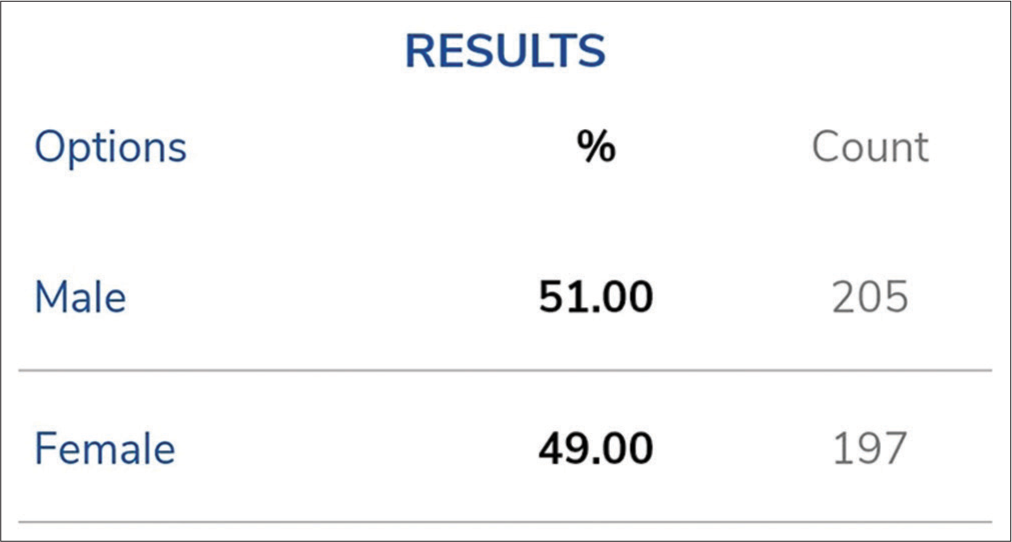
- Gender-wise participants’ distribution.
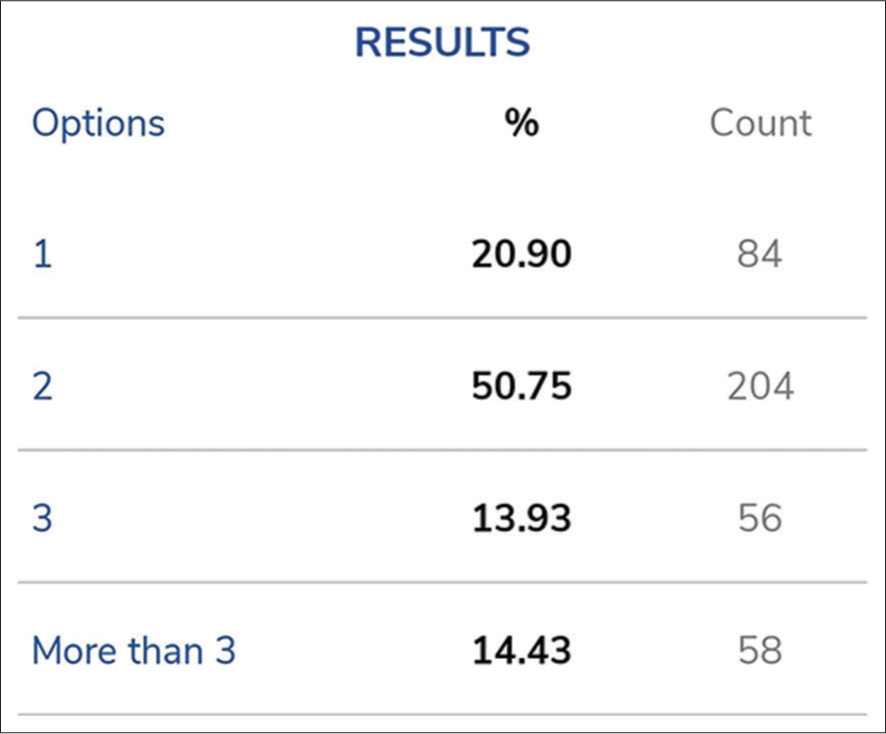
- Participants’ number of dental visits.
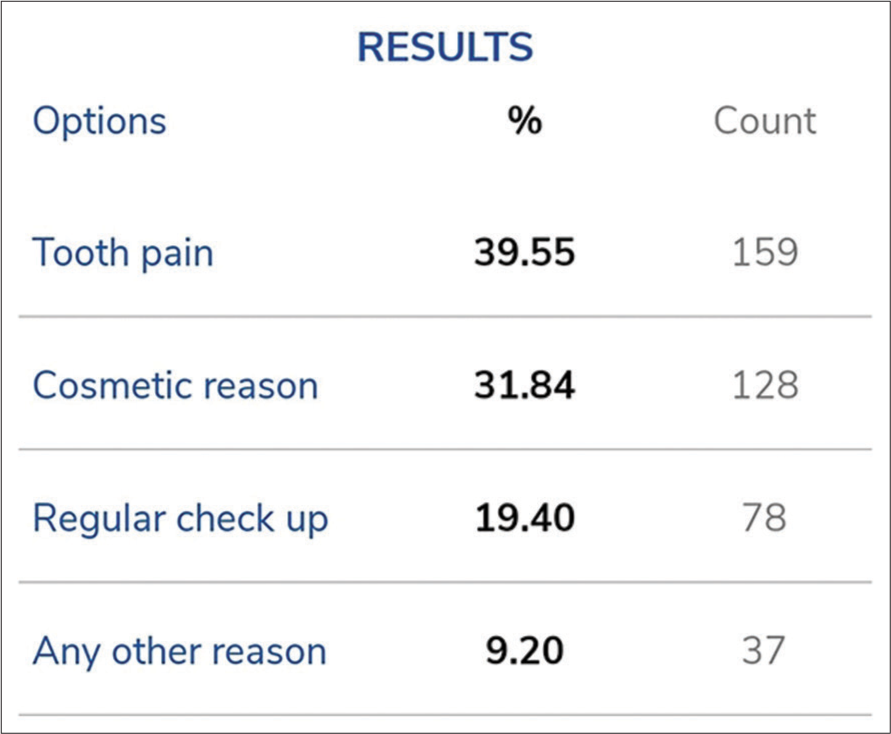
- Participants’ reason for dental visits.

- Participants’ state of mind before dental visit.

- Participants’ response to level of dental anxiety.
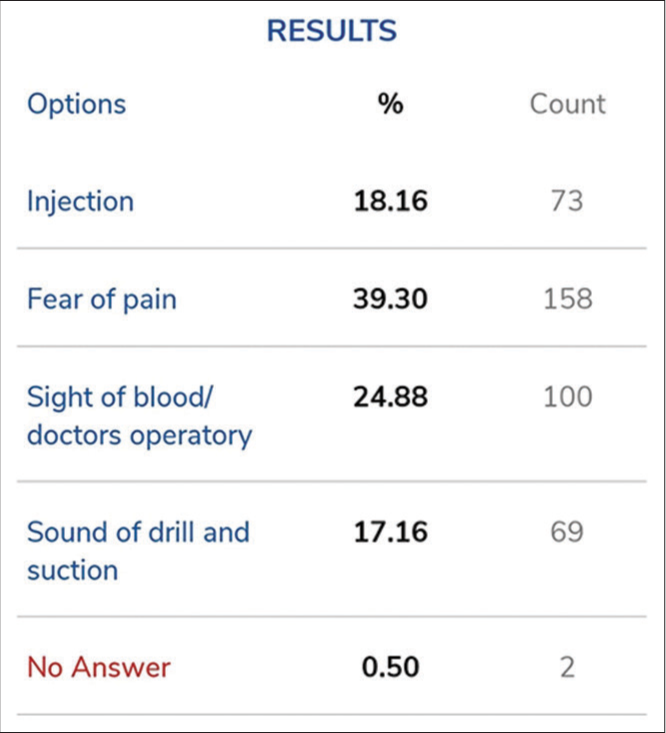
- Participants’ reasons for fear of dental treatment.

- Participants’ responses regarding how their dental fear started.

- Participants’ responses on physical manifestations of their dental fear.

- Participants’ responses on time of maximum dental fear.
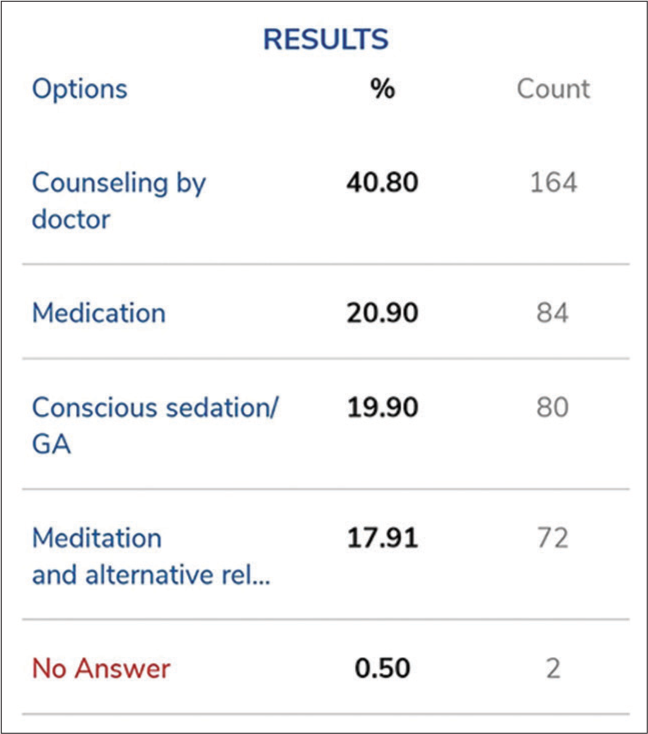
- Participants’ responses on how they prefer to control their anxiety.

- Participants’ responses on type of dental procedure that causes anxiety.
When asked about the reason behind their fear of dental treatment, 39.30% (158) of the study population claim it to be fear of pain which they could experience during the various treatments such as root canals and extractions. About 18% (69) of the population had a fear of the injections or the other sharp, pointed instruments used by dentists. About 25% (100) of the study population is afraid of the sight of the blood and doctors operating. About 17% (69) of the participants had a fear of the sound of drill and suction. When asked if there is any physical manifestation of fear faced by them during the dental treatment, 40% of them replied it to be dizziness, whereas 20% (80) faced sweating and tremors. When asked about how their fear started, 28.2% (113) of them responded it to be due to their bad previous experiences. About 20.8% (83) heard negative experiences from others, which led it to develop dental fear. About 13.2% (53) fear the dental visit due to their previous encounter with an unempathetic dentist.
37.8% (151) of the participants are unaware of the reason behind dental fear and anxiety. When asked about the moment they felt that their fear was at the peak, 51.8% (206) of the participants responded it to be during the treatment. About 28.1% (112) experience fear in the waiting lobby. About 14.1% (56) experiences it on the previous night before the treatment. About 6% (24) experience it after the procedure. When asked about how they would prefer to control their anxiety, about 41% (164) of the participants prefer counseling by doctors. About 21% (84) would like to be prescribed the medication. About 20% (80) would prefer conscious sedation or get general anesthesia, while 18% (72) believe in meditation and alternative relaxation techniques. When asked about the particular dental procedure that causes the most dental anxiety, 44% (176) of the participants responded it to be extractions. About 27.5% (110) of them is afraid of root canal treatment. About 12.2% (39) of the participants were afraid of scaling. About 16.2% (65) are afraid of other dental procedures other than RCT, extraction, and scaling.
DISCUSSION
The main objective of this study was to evaluate and assess fear and anxiety in the general population toward dental treatment, which leads to negligence of good oral hygiene, which can ultimately lead to poor oral hygiene.
The study focuses on the emotional state of the general population during dental treatment. According to the outcome of the study, the participants were unaware of the complex psychological problems that can have significant effects on the lives of the participants, such as avoidance of increased dental caries or poor health-related quality of life. It was observed that most of the patients avoided dental visits due to fear and anxiety even after the need of the treatment. Participants experience increasing in muscular tension and increase in blood pressure. About 20.1% of the participants experienced sweating, and 40.5% of the participants experienced lightheadedness, which further increased their dental anxiety. These physical manifestations may be perceived as a threat to participant’s internal world, leading to feelings of panic and anxiety. 51.8% participants reported that their fear is at peak level when the treatment is ongoing. About 28.1% experienced it in the waiting lobby. These observations suggest that participants are phobic. They should be referred to secondary-level care, such as psychological or pharmacological treatment. There are clearly many different etiological factors in the development of dental fear and anxiety. It was observed that 28.2% of the participants developed the fear due to their bad previous experiences. An individual may have had a negative experience of visiting the dental clinic in the past, which is more likely to have occurred in childhood. About 20.8% of the participants develop the fear because they have known someone, most likely their friends and family who had a past negative experience. A person may be afraid of the dentist for one or all of the reasons or even due to an interaction between them. Indeed, an individual who is highly neurotic may be subsequently more vulnerable to a negative experience than someone who is highly extroverted. From this study, it is difficult to understand whether the experiences were traumatic or subjects that were sensitive to dental treatments.[5]
To control the patient’s dental anxiety and fear few important steps should be taken by the dental practitioners such as conducting individual counseling sessions for the patients having moderate or severe dental anxiety. Meditation and alternative relaxation techniques should be explained to the patient’s moderate or severe dental anxiety.[6]
CONCLUSION
Participants in the research had a knowledge of the consequences of postponing dental care. Dental treatment is delayed due to dental fear and anxiety. Participants thought that they needed good medical advice as well as proper education on alternative relaxing methods like meditation. The study focuses on how people emotionally react to receiving dental care in general. The influence of dental anxiety and fear on oral hygiene and health is stronger dental anxiety and fear negatively impacts oral health and hygiene. Dentists, hygienists, and other dental health professionals who work to maintain patient’s oral health and who are aware of dental anxiety and fear can make a significant contribution to increasing public awareness and educating the public, as well as providing patients with counseing and relaxation techniques.
Limitations
Participants are the patients visiting a dental college who were involved.
The results might not accurately represent how the general population feels about dental anxiety and fear.
Ethical approval
The author declare that they have taken the Institutional Ethics Committee approval and the approval number is IEC/VSPMDCRC/113/2022.
Declaration of patient consent
The authors certify that they have obtained all appropriate patient consent.
Conflicts of interest
Dr. Alka Dive is on the Editorial Board of the Journal.
Use of artificial intelligence (AI)-assisted technology for manuscript preparation
The authors confirm that there was no use of artificial intelligence (AI)-assisted technology for assisting in the writing or editing of the manuscript and no images were manipulated using AI.
Financial support and sponsorship
Nil.
References
- Can you read my poker face? A study on sex differences in dentophobia. Eur J Oral Sci. 2013;121:465-70.
- [CrossRef] [PubMed] [Google Scholar]
- Why are people afraid of dentist? Observation and explanation. Med Princ Pract. 2014;23:295-301.
- [CrossRef] [PubMed] [Google Scholar]
- What goes around comes around: Revisting the hypothesized vicious cycle of dental fear and avoidance. Community Dent Oral Epidemoil. 2013;41:279-87.
- [CrossRef] [PubMed] [Google Scholar]
- The fear of dental pain Questainnare: Construction and validity. Eur J Oral Sci. 2003;111:12-8.
- [CrossRef] [PubMed] [Google Scholar]
- Adult dental health survey 2009: Relationships between dental attendance patterns, oral health behavior and the current barriers to dental care. Br Dent J. 2013;214:25-32.
- [CrossRef] [PubMed] [Google Scholar]
- Dental anxiety and influencing factors: A cross-sectional questionnaire-based survey. Indian J Dent Res. 2018;29:10-5.
- [CrossRef] [PubMed] [Google Scholar]
